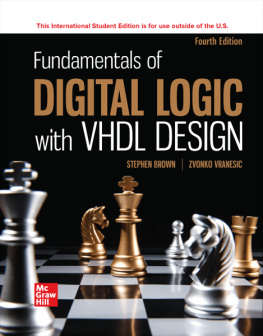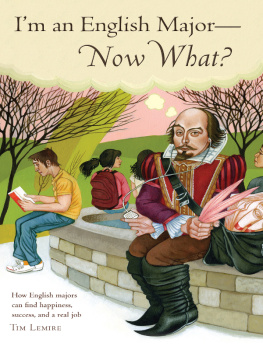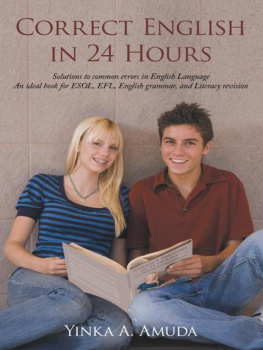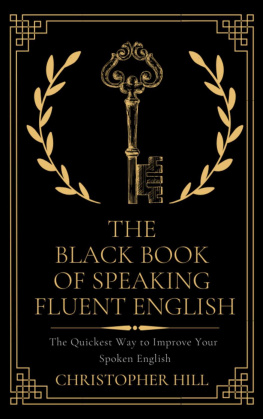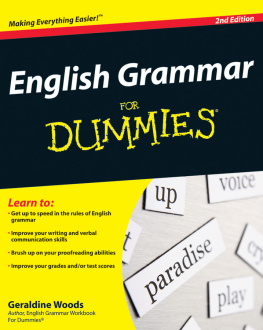Improve
your
ENGLISH
ENGLISH
in the WORKPLACE
Improve
your
ENGLISH
ENGLISH
in the WORKPLACE
Stephen E. Brown and Ceil Lucas


Copyright 2009 by Stephen E. Brown and Ceil Lucas. All rights reserved. Manufactured in the United States of America. Except as permitted under the United States Copyright Act of 1976, no part of this publication may be reproduced or distributed in any form or by any means, or stored in a database or retrieval system, without the prior written permission of the publisher.
978-0-07-159587-2
The material in this eBook also appears in the print version of this title: 0-07-149718-8.
eBook conversion by codeMantra
Version 2.0
All trademarks are trademarks of their respective owners. Rather than put a trademark symbol after every occurrence of a trademarked name, we use names in an editorial fashion only, and to the benefit of the trademark owner, with no intention of infringement of the trademark. Where such designations appear in this book, they have been printed with initial caps.
McGraw-Hill eBooks are available at special quantity discounts to use as premiums and sales promotions, or for use in corporate training programs. For more information, please contact George Hoare, Special Sales, at george_hoare@mcgraw-hill.com or (212)904-4069.
TERMS OF USE
This is a copyrighted work and The McGraw-Hill Companies, Inc. ("McGraw-Hill") and its licensors reserve all rights in and to the work. Use of this work is subject to these terms. Except as permitted under the Copyright Act of 1976 and the right to store and retrieve one copy of the work, you may not decompile, disassemble, reverse engineer, reproduce, modify, create derivative works based upon, transmit, distribute, disseminate, sell, publish or sublicense the work or any part of it without McGraw-Hill's prior consent. You may use the work for your own noncommercial and personal use; any other use of the work is strictly prohibited. Your right to use the work may be terminated if you fail to comply with these terms.
THE WORK IS PROVIDED "AS IS." McGRAW-HILL AND ITS LICENSORS MAKE NO GUARANTEES OR WARRANTIES AS TO THE ACCURACY, ADEQUACY OR COMPLETENESS OF OR RESULTS TO BE OBTAINED FROM USING THE WORK, INCLUDING ANY INFORMATION THAT CAN BE ACCESSED THROUGH THE WORK VIA HYPERLINK OR OTHERWISE, AND EXPRESSLY DISCLAIM ANY WARRANTY, EXPRESS OR IMPLIED, INCLUDING BUT NOT LIMITED TO IMPLIED WARRANTIES OF MERCHANTABILITY OR FITNESS FOR A PARTICULAR PURPOSE. McGraw-Hill and its licensors do not warrant or guarantee that the functions contained in the work will meet your requirements or that its operation will be uninterrupted or error free. Neither McGraw-Hill nor its licensors shall be liable to you or anyone else for any inaccuracy, error or omission, regardless of cause, in the work or for any damages resulting therefrom. McGraw-Hill has no responsibility for the content of any information accessed through the work. Under no circumstances shall McGraw-Hill and/or its licensors be liable for any indirect, incidental, special, punitive, consequential or similar damages that result from the use of or inability to use the work, even if any of them has been advised of the possibility of such damages. This limitation of liability shall apply to any claim or cause whatsoever whether such claim or cause arises in contract, tort or otherwise.
To obtain material from the disk that accompanies the printed version of this eBook, please .
CONTENTS
ACKNOWLEDGMENTS
We are very grateful to Patrick Harris for his excellent work filming and editing the download. We thank all of the people who were willing to be interviewed and also Holly McGuire, Christopher Brown, and Julia Anderson Bauer of McGraw-Hill Professional; Jim Dellon, Ivey Wallace, and Jayne McKenzie of Gallaudet University; Kevin Keegan of Hubert Blake High School in Silver Spring, Maryland; Mike Solano and Merchant's Tire in Laurel, Maryland; and Jim Smith, Kim MacKenzie Smith, and The Skydivin' Place in Kingsdale, Pennsylvania.
INTRODUCTION
English in the Workplace consists of ninety-one interview segments with everyday people, not actors, speaking English in the United States. The interviews are organized into ten chapters. Each chapter focuses on a different aspect of work, from looking for work and interviewing for jobs to communicating and using technology at work. The goal in using an interview format was to elicit natural speech and to allow the speakers to express themselves as freely and naturally as possible. In these interviews, you will hear the vocabulary and sentence structures that real speakers use to talk about their working lives.
Because we wanted to provide learners of English with natural models of spoken English in the United States, those being interviewed did not memorize or rehearse their remarks. You will meet people of all ages and nationalities, from all walks of life: a policeman, a nurse, accountants, a paramedic, a student, teachers, a librarian, a mechanic, an IT professional, a travel agent, a sign language interpreter, musicians, and others.
Each chapter includes the complete transcript of each interview segment as well as definitions of vocabulary words, idioms, and constructions whose meanings or cultural references may not be immediately obvious to a nonnative English speaker. You will find questions and exercises at the end of each chapter that are relevant to both the text of the interview and your own personal experiences. We recommend that you consult a comprehensive American English dictionary in conjunction with the use of the download and workbook.
ABOUT THE TRANSCRIPTS
What you will hear on the downlaod and see in the transcripts are examples of actual speech. Our goal is to provide examples of English as it is spoken by a wide range of people in the United States today. You will hear speakers from many statesMaryland, New Jersey, Massachusetts, Arkansas, Illinois, Maine, Minnesota, and Michiganas well as speakers from Canada, India, Guyana, England, New Zealand, Cameroon, Egypt, and Spain. Also, you will hear one speaker whose speech has many features of what is known as African-American Vernacular English (AAVE). So you will hear English spoken with many different accents. You will also see a deaf user of American Sign Language (ASL) with her interpreter.
You will notice that while all of the speakers are fluent, they sometimes use what some consider nonstandard or even ungrammatical forms of English. And you will see that not only do the nonnative speakers use these forms, but native speakers of American English frequently use them as well. Some of these speakers are very fluent users of varieties of English used in other countries, such as India, varieties that have been referred to as "World Englishes" and that differ from American or British English in very systematic and nonrandom ways.
You will notice that when people speak, it is not at all like a newscast being read by an anchorperson on the evening news or like the written language that you might see in textbooks. You will see that people don't always speak in complete sentencesthey hesitate; they interrupt themselves; they correct themselves; they start one sentence, give it up, and go on with another one. While the speakers clearly knew that they were being filmed, what you see and hear is, for the most part, very natural speech. Our goal was to reflect this naturalness in the transcripts. Interjections and discourse markers such as
Next page

